Cable Rod limits
If you go with Voile springs and cable rods, or Kreuzspitze springs and rods, you will be able to fit any size boot but need a post to hook them on to, like Kreuzspitze or B&D. Voile’s sizing system of — long and short cable rods, plus long and short spring cartridges and long and short yokes for the heel lever, and heel levers — will fit pretty much any boot with a forward pivot (OMG. If you have a small foot, and want an aggressive pivot, plan to shorten or add threads to the short cable rods and make sure the yoke is the short version. If you want lots of spring travel too (with small feet), go with Kreuzspitze. This is pretty much the same system as Voile or OMG except the springs are universally longer so you can flex further before limiting out. The difference in travel distance is only millimeters, but that translates to extra degrees of forward rotation.The OMG system has fewer miles on it so I took the time to map out what combinations of short and long cable rods work with Voile’s standard and long springs for each boot size. As the tables below show, for a 60 mm pivot you can fit small to large boots (mondo 22 – 28, BSL: 275-310) with a small cable rod. For size 28.5 and larger, you need the large cable.
In the tables below green cells mean the specific combination of cable rod and spring for each column will fit that size boot for the pivot location of each table; red is outside the cable size range, while orange is on the edge but might work.
Cable/boot compatibility for 49mm pivot, 20mm heel post:
| 49mm Pivot | Short Rod/Std Spg | Short Rod/Long Spg | Long Rod/Std Spg | Long Rod/Long Spg |
| Cable Length | 220-245mm | 240-265mm | 245-290mm | 265-310mm |
| 298.8 mm | 30-30.5 | 30-30.5 | 30-30.5 | 30-30.5 |
| 286.3 mm | 29.5-30 | 29.5-30 | 29.5-30 | 29.5-30 |
| 278.6 mm | 28.5-29 | 28.5-29 | 28.5-29 | 28.5-29 |
| 269.9 mm | 27.5-28 | 27.5-28 | 27.5-28 | 27.5-28 |
| 261.3 mm | 26.5-27 | 26.5-27 | 26.5-27 | 26.5-27 |
| 253.7 mm | 25.5-26 | 25.5-26 | 25.5-26 | 25.5-26 |
| 245.7 mm | 24.5-25 | 24.5-25 | 24.5-25 | 24.5-25 |
| 238.1 mm | 23.5-24 | 23.5-24 | 23.5-24 | 23.5-24 |
| 230.5 mm | 22.5-23 | 22.5-23 | 22.5-23 | 22.5-23 |
Cable/boot compatibility for 61mm pivot, 20mm heel post:
| 61mm Pivot | Short Rod/Std Spg | Short Rod/Long Spg | Long Rod/Std Spg | Long Rod/Long Spg |
| Cable Length | 220-245mm | 240-265mm | 245-290mm | 265-310mm |
| 287.2 mm | 30-30.5 | 30-30.5 | 30-30.5 | 30-30.5 |
| 274.7 mm | 29.5-30 | 29.5-30 | 29.5-30 | 29.5-30 |
| 267.0 mm | 28.5-29 | 28.5-29 | 28.5-29 | 28.5-29 |
| 258.4 mm | 27.5-28 | 27.5-28 | 27.5-28 | 27.5-28 |
| 249.8 mm | 26.5-27 | 26.5-27 | 26.5-27 | 26.5-27 |
| 242.2 mm | 25.5-26 | 25.5-26 | 25.5-26 | 25.5-26 |
| 234.3 mm | 24.5-25 | 24.5-25 | 24.5-25 | 24.5-25 |
| 226.8 mm | 23.5-24 | 23.5-24 | 23.5-24 | 23.5-24 |
| 219.2 mm | 22.5-23 | 22.5-23 | 22.5-23 | 22.5-23 |
Cable/boot compatibility for 73mm pivot, 20mm heel post:
| 73mm Pivot | Short Rod/Std Spg | Short Rod/Long Spg | Long Rod/Std Spg | Long Rod/Long Spg |
| Cable Length | 220-245mm | 240-265mm | 245-290mm | 265-310mm |
| 275.7 mm | 30-30.5 | 30-30.5 | 30-30.5 | 30-30.5 |
| 263.2 mm | 29.5-30 | 29.5-30 | 29.5-30 | 29.5-30 |
| 255.6 mm | 28.5-29 | 28.5-29 | 28.5-29 | 28.5-29 |
| 247.0 mm | 27.5-28 | 27.5-28 | 27.5-28 | 27.5-28 |
| 238.6 mm | 26.5-27 | 26.5-27 | 26.5-27 | 26.5-27 |
| 230.9 mm | 25.5-26 | 25.5-26 | 25.5-26 | 25.5-26 |
| 223.0 mm | 24.5-25 | 24.5-25 | 24.5-25 | 24.5-25 |
| 215.5mm | 23.5-24 | 23.5-24 | 23.5-24 | 23.5-24 |
| 208 mm | 22.5-23 | 22.5-23 | 22.5-23 | 22.5-23 |
Cable/boot compatibility for 85mm pivot, 20mm heel post:
| 85mm Pivot | Short Rod/Std Spg | Short Rod/Long Spg | Long Rod/Std Spg | Long Rod/Long Spg |
| Cable Length | 220-245mm | 240-265mm | 245-290mm | 265-310mm |
| 264.2 mm | 30-30.5 | 30-30.5 | 30-30.5 | 30-30.5 |
| 251.7 mm | 29.5-30 | 29.5-30 | 29.5-30 | 29.5-30 |
| 244.1 mm | 28.5-29 | 28.5-29 | 28.5-29 | 28.5-29 |
| 235.6 mm | 27.5-28 | 27.5-28 | 27.5-28 | 27.5-28 |
| 227.1 mm | 26.5-27 | 26.5-27 | 26.5-27 | 26.5-27 |
| 219.6 mm | 25.5-26 | 25.5-26 | 25.5-26 | 25.5-26 |
| 211.7 mm | 24.5-25 | 24.5-25 | 24.5-25 | 24.5-25 |
| 204.3 mm | 23.5-24 | 23.5-24 | 23.5-24 | 23.5-24 |
| 196.8 mm | 22.5-23 | 22.5-23 | 22.5-23 | 22.5-23 |
The tables above only determine whether the cable/spring combo will fit the boot for a âstandardâ height tech toe, meaning pins 27 mm above the ski deck with a heel post 20 mm high. Notice that small boots only work for pivot positions forward of 65mm with short cable rods. If you use a higher toe (G3’s Ion) and subsequent heel post, even fewer small boots will work unless you shim the cable post from below.
Even though the OMG short cable rods have 45mm of thread on the ends (1¾”), the spring cartridges will hit the bend in the rod at around 25mm (1″) of thread depth. That’s why the short rod cable assemblies only show 25mm of adjustment range in the tables above. Nonetheless, for average sized feet, the short rod with either spring should fit fine for most pivot locations.
Springs: Size matters
In practice the factor making a TTS binding fun to ski is how far you can lift your heel before the springs limit out. In general it is easy to show that you get more range of motion with a forward pivot and/or a spring with more travel distance, which is typically a third to a quarter of the total length.
It doesn’t take long to realize springs for a 2-pin tele system need a larger compression range, particularly for stiffer springs, than are available from Voile’s springs built for 75mm bindings. This is more true for guys with boots larger than 28.5 that want a stiff spring. You can figure this out yourself by solving for the intersection of two circles using quadratic equations, or sketching it out with an accurately scaled graph and a compass.
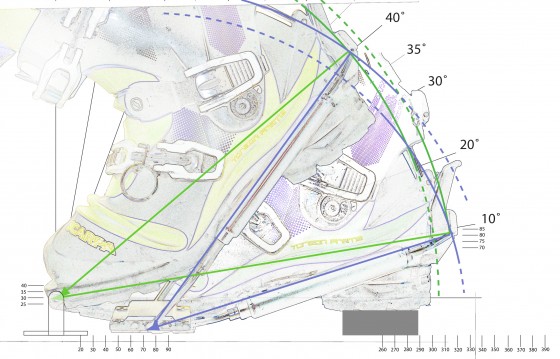
Determining the limit of heel lift by drawing the intersection of two circles; the radius of the heel throw about the toe pins, and the radius of the stretched cable where the spring is limiting out.
If you take the time to calculate it you will find that for stock 75mm springs, with a travel distance of approximately 35mm, you will feel the spring begin to limit out in the range of 30° to 39° depending primarily on the pivot location. Further forward yields a 39° limit, and an aggressive pivot further back only 30°. You can add a degree of mobility for smaller feet, or subtract with larger.
Increase the spring travel distance 10mm (~â ”) and the range improves almost 10°, from 30°â39° for an inch of compression (1″=24.5mm), to 37°â50° for 1½” (~35mm). Again, a higher range of motion before limiting out the further forward the cable pivot is and the smaller the boot, or less as the pivot moves back and boots get longer.
Estimated boot range of motion with standard and long springs.
| Spring TD | Std: 25mm (solid @ 35mm) | Long: 35 mm (solid @ 45mm) | ||
| Pivot | sz 24 (BSL:275) | Sz 30 (BSL:333) | sz 24 (BSL:275) | Sz 30 (BSL:333) |
| 47 mm | 39.4° | 38° | 49.7° | 48.5° |
| 85 mm | 30.9° | 30° | 37.7° | 37° |
The angles computed above are not the limit to your leg range of motion. First, there’s another 10mm of spring compression available, which should allow another 10° of rotation. Plus you can add in the flexibility of the bellows and cuff to increase leg mobility another 35°â40°. Depending on how deep you go, that may be enough. I used compression values less than the max because the spring compression forces change exponentially as you approach max compression, and non-linear when they go solid. You might experience more range of motion than my numbers indicate, but only for brief moments, like in a crash or a deep knee tele bounce.
Response from those who have tried the longer springs is they provide enough range of motion, but they’re too soft. One person I know combined the soft feel with an aggressive pivot and they like the sensation. For reference they like Switchbacks.
Compression travel distance for Voile/OMG/Kruezspitze springs
| Mfg | Soft | Medium | Stiff | |
| OMG / Voile | 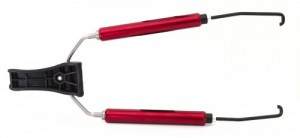 |
45mm | 39mm | 35mm |
| Kreuzspitze | 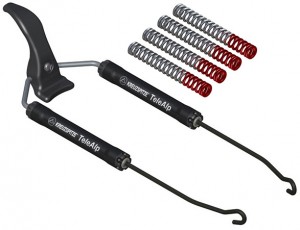 |
48mm | 42mm | 37mm |
| G3 | 35 | 33 | 30 |
Compression travel distance for 22D Axl springs
| Mfg | Axl Long | Axl Stiffy | Axl Std |
| 22D | 65mm (2.57″) | 64mm (2.53″) | 50mm (1.99″) |
To be more useful/acceptable to a larger number of tele skiers the entire cable system needs to be engineered from scratch, not using conveniently available cable systems developed for side-routed 75mm bindings (Voile, Targa, Cobra, etc.). One consequence of longer springs will be additional weight.
Heel Lever
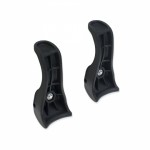 |
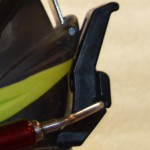 |
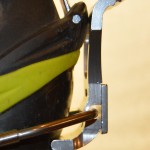 |
| Voile – GOOD | OMG – BETTER | Bishop – BEST |
The final component you need to pay attention to in the cable assembly is the heel throw (or lever). Most are designed to work in the heel groove of a 75mm boot. This groove is absent on NTN boots, forcing the lever to be up on the heel step. The net result is many heel levers designed for 75mm boots don’t close with a resounding snap on the heel step. It might hold and it might not. At some point it’s bound to fall off unexpectedly. And it feels sloppy so the the springs engage unevenly.
The good news is the heel lever for OMG cables works beautifully. In fact, there’s only one heel throw I’ve tested that snaps on tighter; a Bishop heel lever. The Voile black heel lever works well, but it doesn’t snap as snug as the OMG. Same for a Cobra heel lever, if you can find one. G3 Targa levers do not work well, nor do the Voile heel levers prior to 2014 (grey). It doesn’t hurt to be creative; Nviglio found a BD crampon heel lever worked well. To work properly the heel lever needs to be over center when snapped onto the heel.
Shimming
Shimming may be required for the cable block, or the toe, or the heel, depending on how much ramp angle you like. Do you like your foot level when you’re standing on your heels, or do you prefer your heel raised above the toe and if so, by how much? The answer to that question will determine how much you may need to shim underneath the bellow of the boot so it doesn’t sag when standing flat. Whether you shim above or below the cable block depends on how active you want the binding to be.
Remember, one millimeter down is like two back. If you want to increase activity, shim above the cable block. To reduce activity, shim beneath. This is another way you can fine tune the power delivered in the cable in combination with selecting a stiffer or softer spring. You can shim the toe, the cable post, and heel post up or down to achieve the final desired effect. The higher the pins on the toe, the more shimming you can expect to create. For instance with a G3 Ion toe you will need to shim the cable post at least 10mm to prevent the boot bending when standing flat, probably more depending on your ramp angle.
Conclusion
As you’ve realized, embarking on a DIY telemark binding project is not trival. However, building your own 2-pin telemark binding IS possible, and if you plan it well, the results will be satisfying, especially for the turn earners among you. For this sort of system to gain larger acceptance it is clear that the cable assembly, from the adjustability of the pivot location to the range of motion and tension allowed by the springs needs a serious overhaul. But for those who don’t mind tinkering, the future is here today.
As an example, consider what one intrepid engineer put together.

Jason Quinata’s POLR binding.
Granted, this is the same engineer that gave us Flick-Lock® adjustable ski poles, so this is not an example of amateur hour, but a pro using his passion to build a 2-pin tele trap. However, the tools exist for you to do likewise.
Related Posts
2-pin Tele Chronicles: State of the Art
2-pin Tele Chronicles: Picking your toes
2-pin Tele Chronicles: Use the Force Luke
2-pin Tele Chronicles: Cobbling the Cable
Calculate the intersection of two circles
© 2017

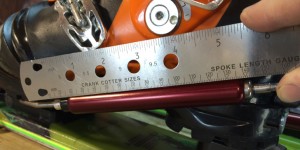
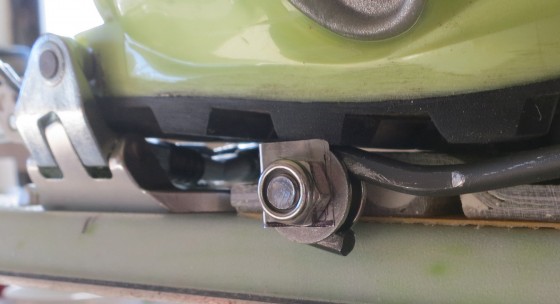
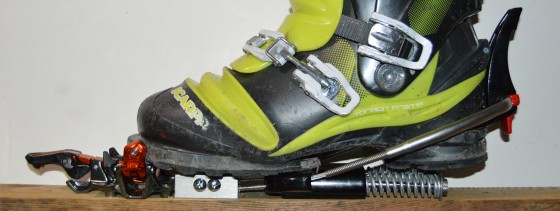
5 comments
Skip to comment form
Wow, great stuff Craig, I’ll keep tis post as a reference for sure
This is awsome, but pondering it all since it first came out, I finally saw the analysis is ‘missing’ looking at the impact of the height in which the rear clamp holds the rod to the boot back. Wow. If we move it up the spring begins to start out with a steeper angle. Importantly, the change in rod length from the boot-heal-on-ski to boot-fully-raised is shortened. Since we need less change-in-length for boot movement, we can increase pre-compression when the the boot is in down position. This means more ‘immediate’ activity when the heal rises the first couple inches. This all is especially important for big feet.
I have a lot to say about Springs and Heel Throws after skiing this season on the Kreuspitze Tele Alp with OMG Long Springs/Voile Heel Throw. 1. Do NOT use a Voile heel throw. You will release unexpectedly and I hope you have leashes on! It has happened to me several times. I will be looking to get an OMG, but see below. 2. I use the back pivot point (everything else feels too sloppy and soft) with the OMG Long Spring set-up. The feel is great and I can get really low…But…..the soft springs cannot take the abuse of an aggressive skiier. I blew up the springs in 10 days of skiing and worse, I cannot get OMG to respond to emails or voicemails. I am just thinking of buying a Medium stiff Kreuspitze heel assembly. Does anyone have experience with these? I need the spring travel for my tele style but also a little more activity would be nice. For reference, I feel great on Axl’s in the rear pivot point with stiff springs. But I am also ok with a lighter spring that will travel more. I use to be fine on Switchback X’s, except for all the breakage and binding rippage. Any help here would be appreciated.
re: “breakage and binding rippage” on Switchbacks? That’s unusual, not impossible. As to the Voile heel throw, if you’re using the older grey version, those definitely do not hold on the heel step, the black ones, while not as good as OMG’s heel throw, are usually sufficient. Obviously YMMV. The Kruez springs are longer than OMG standard springs so the medium will probably suit your purposes. Again, no guarantees, but reports from others indicate the Kruez springs work well. They can also be swapped, but disassembling the cartridges requires the right tools and some skill/luck, neither of which anyone really has – I mean, who has a PhD in Kruez spring assembly (besides Kruez employees)?
I am using the Voile black heel throws. They don’t really snap!!! on, only if you have the compression on the springs overly tight. I think I’m going to junk the OMG assembly and “spring” for the Kruezspitze. I mite as well have a PHD in Kruezspitze with all the monkeyin’ around I’ve been doing with them. Do you think the Kruez soft spring has similar feel to OMG with the same or more travel? Or shud I just go Medium? I would go stiff, but I think I wouldn’t get enough travel……